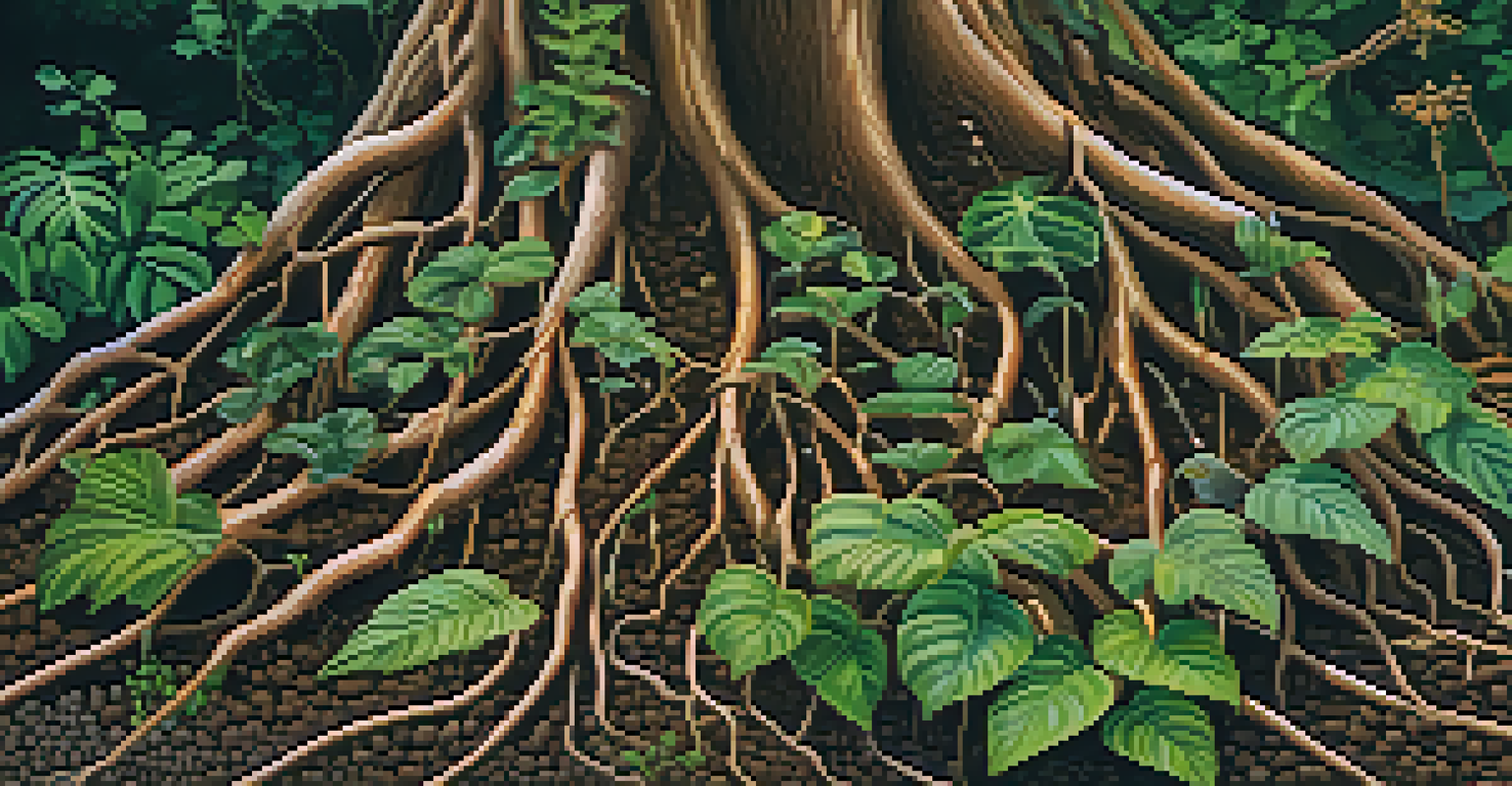Native Plants: Natural Solutions for Soil Erosion Issues

Understanding Soil Erosion and Its Consequences
Soil erosion is a natural process, but human activities can accelerate it significantly. Factors like deforestation, agricultural practices, and urban development disturb the soil's natural structure, leading to increased erosion. When the topsoil washes away, it can result in reduced agricultural productivity and environmental degradation.
The soil is the great connector of our lives, the source and destination of all. Food, fiber, shelter, biodiversity, and even our atmosphere are all linked to the soil.
The impact of erosion extends beyond just the loss of soil; it can lead to sedimentation in waterways, harming aquatic habitats. This sediment can carry pollutants, further degrading water quality. Additionally, erosion contributes to the loss of valuable nutrients, making it harder for plants to thrive and disrupting local ecosystems.
Addressing soil erosion is crucial for maintaining healthy landscapes. One of the most effective solutions lies in using native plants that are well-suited to local conditions and can help anchor the soil. By reintroducing these plants, we can not only combat erosion but also restore balance to the ecosystem.
The Role of Native Plants in Soil Stabilization
Native plants are those that naturally occur in a specific region and have adapted to local climate, soil, and wildlife. Their deep root systems play a vital role in anchoring soil, which helps reduce erosion. These roots not only hold the soil in place but also improve soil structure and health over time.

Unlike non-native species, native plants require less water, fertilizer, and pesticides, making them a sustainable choice for soil stabilization. They thrive in their natural environment, which means they can withstand local weather conditions and pests better. This resilience further contributes to their ability to prevent erosion effectively.
Soil Erosion's Human Impact
Human activities like deforestation and urban development significantly accelerate natural soil erosion, leading to severe environmental consequences.
Additionally, native plants provide habitat for local wildlife, fostering biodiversity while also enhancing the landscape's aesthetic appeal. By choosing native flora, we can create beautiful, functional spaces that support both the environment and our communities.
Benefits of Using Native Plants for Erosion Control
Utilizing native plants for erosion control comes with a myriad of benefits. Firstly, these plants improve soil health by promoting organic matter and increasing microbial activity. Healthy soil is less prone to erosion, creating a self-sustaining environment.
Restoration is a process, not a destination. It is about the journey to healing our ecosystems and ourselves.
Another significant advantage is the reduction in maintenance costs. Native plants typically require less watering and care once established, making them a cost-effective solution for landowners. This not only saves money but also time, allowing you to enjoy your landscape rather than constantly tending to it.
Moreover, native plants contribute to water conservation. Their natural adaptation to local climates means they can thrive with minimal irrigation, which is especially important in areas prone to drought. This characteristic makes them a smart choice for sustainable landscaping.
Selecting the Right Native Plants for Your Area
When choosing native plants, it's essential to consider your local ecosystem and soil type. Local extension services or native plant societies can offer valuable guidance on which species are most effective for erosion control in your area. This ensures that you select plants that will thrive and provide maximum stabilization.
Additionally, consider the growth habit of the plants. Ground covers, for instance, are excellent for preventing soil erosion on slopes, while deeper-rooted grasses can help stabilize loose soil. Mixing various species can also create a resilient plant community, enhancing the overall effectiveness of your erosion control efforts.
Native Plants Stabilize Soil
Utilizing native plants with deep root systems effectively anchors soil, reduces erosion, and enhances local ecosystems.
Don’t forget to assess the sunlight and moisture conditions of your site. By matching plant selections to these conditions, you’ll ensure that they flourish and provide the necessary support to combat erosion effectively. This thoughtful approach will lead to a more sustainable and thriving landscape.
Creating a Native Plant Erosion Control Plan
Developing an erosion control plan using native plants involves a few critical steps. Start by conducting a site assessment to identify areas most at risk for erosion. Look for signs such as exposed soil, runoff patterns, and vegetation loss, which will guide your planting strategy.
Next, outline your goals for the area. Are you looking to restore a specific habitat, enhance aesthetics, or improve soil health? Having clear objectives will help you select the right native plants and determine the best planting techniques. Consider factors like plant spacing and layering to maximize coverage and effectiveness.
Finally, implement your plan with care. Proper planting techniques, such as ensuring adequate soil contact and avoiding compaction, will help your native plants establish successfully. Regular monitoring and maintenance will ensure their continued growth and strength, ultimately leading to effective erosion control.
Case Studies: Success Stories of Native Plant Erosion Control
Several communities have successfully implemented native plant strategies to combat soil erosion. For example, a coastal town in California used native grasses and shrubs to stabilize dunes and protect against wind and water erosion. This project not only enhanced the landscape but also improved local biodiversity and recreation opportunities.
In the Midwest, a rural area faced severe topsoil loss due to agricultural runoff. By replacing conventional crops with native prairie grasses, farmers reported a remarkable decrease in erosion rates. This shift not only protected their soil but also increased water retention and supported wildlife.
Successful Erosion Control Examples
Communities have successfully implemented native plant strategies to combat soil erosion, showing significant improvements in soil health and biodiversity.
These success stories highlight the power of native plants in erosion control. By learning from these examples, other regions can adopt similar strategies, tailoring them to their specific conditions and challenges.
Conclusion: The Future of Erosion Control with Native Plants
In conclusion, native plants offer a sustainable and effective solution to soil erosion issues. By leveraging their natural adaptations, we can stabilize soil, improve ecosystem health, and enhance the beauty of our landscapes. The benefits extend beyond mere aesthetics; they contribute to the overall well-being of our environment.
As we face increasing environmental challenges, such as climate change and habitat loss, embracing native flora becomes more crucial than ever. By fostering a deeper understanding of these plants and their role in our ecosystems, we can make informed choices that benefit both our communities and the planet.

Let’s take action today by advocating for the use of native plants in erosion control efforts. Together, we can create resilient landscapes that not only combat soil erosion but also support thriving ecosystems for generations to come.